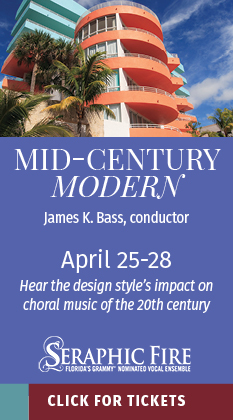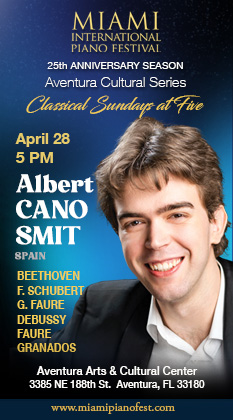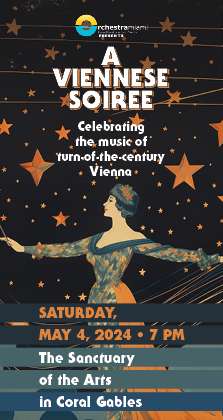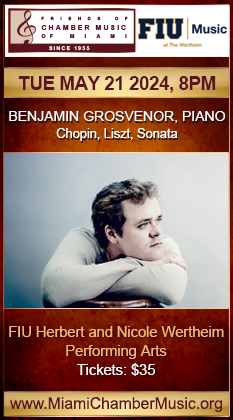New World Symphony’s Cage festival kicks off with generous program of early works
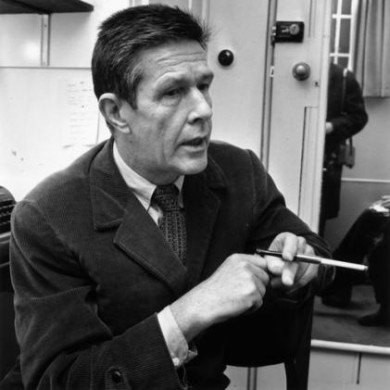
The New World Symphony opened its weekend John Cage festival Friday night with a four-hour program at New World Center.
The New World Symphony’s “John Cage Journey,” which opened Friday evening at New World Center, was an event on the grand scale lasting four hours, illustrating Cage’s growth from classical composer into pioneer of American experimental music. A huge audience of hipsters and intelligentsia stuck it out to the end, moving artistic director Michael Tilson Thomas to exclaim, “I’m so thrilled and proud of you all.”
Tilson Thomas programmed works from the 1940s and 50s, in order to “get a sense of the range of Cage’s early works.” He will lead the NWS into Cage’s more improvisational works tonight and Sunday.
Like a circus in the best sense, the concert featured tableaux, with ensembles placed throughout the hall at multiple levels, creating a constant flow of ideas. Lengthy intermissions permitted sufficient time for the complex setups.
Lighting and video enhanced works like “Summer,” from Cage’s The Seasons, with golden yellow light bathing the orchestra, whose slow, heady dissonances gave the impression of drawing in hot breath. Tilson Thomas expertly carved out the accessible mix of precise doublings and chunky repetitions with a French sensibility.
A grainy black-and-white bird’s-eye view simulcast projection of Anthony Parce’s show-stealing Water Walk cleverly added a period aspect while illuminating the complex, humorous work. Parce, in a white 1940s dinner jacket, re-enacted Cage’s I’ve Got a Secret television performance, dashing among the ‘instruments’: a tub of water, a wind-up fish, birdcalls, a pressure cooker, radio, and various mixed drinks.
The starry soloists—Jessye Norman, Joan La Barbara, Meredith Monk, and Marc-André Hamelin—added their personal stamps to Cage’s hauntingly beautiful vocal and piano music. Norman’s rich, sensual performance expanded the three notes of The Wonderful Widow of Eighteen Springs into limitless possibilities. Tilson Thomas’ tapped piano lid added a beat generation vibe.
Joan La Barbara’s sotto voce purring on She is Asleep, accompanied by Hamelin’s understated muted piano, evoked nighttime rustlings. Hamelin’s masterful prepared piano solo The Perilous Night employed sensitive timbral balance and dynamics to suspend time.
Meredith Monk’s reading of Cage’s graphic score Aria, projected on the walls in real-time, allowed the singer to flex her considerable vocal muscle. Jesse Stiles’ simultaneous surround-sound diffusion of Cage’s electronic piece Fontana Mix added tasteful depth.
Excerpts from Sixteen Dances, capably led by conductor Joshua Gerson, revealed increasing dissonance and silence in Cage’s chamber work. Dancers from the New World School of the Arts illustrated Cage and Merce Cunningham’s longtime partnership of presenting simultaneous but independent works, and Patricia Lent’s choreography of hard and soft lines enchanted.
An early proponent of percussion music, Cage’s motoric rhythms and infectious grooves explored noise as music. Jay Ganser, Rajesh Prasad, Christopher Riggs, and Erick Wood brought the top performances of the night, in Cage’s Living Room Music and Third Construction.
The bravura Living Room Music, set in a bachelor pad with costumed characters and props such as bowling balls and Chinese take-out boxes for instruments, kept the music at the forefront. Third Construction, a rousing finale, with multilayered counterpoint vividly wrought by the quartet’s effortless sense of ensemble, demonstrated both chops and camaraderie.
Cage’s narration of selected stories from Indeterminacy, played between each work, directly touched the heart, de-mystifying the legend.
“A John Cage Journey” continues 7:30 p.m. Saturday at New world Center with Cage’s Song Books and Cheap Imitation/Second Hand. nws.edu; 305-673-3331.
Posted in Performances
Leave a Comment
Sat Feb 9, 2013
at 12:50 pm
No Comments
